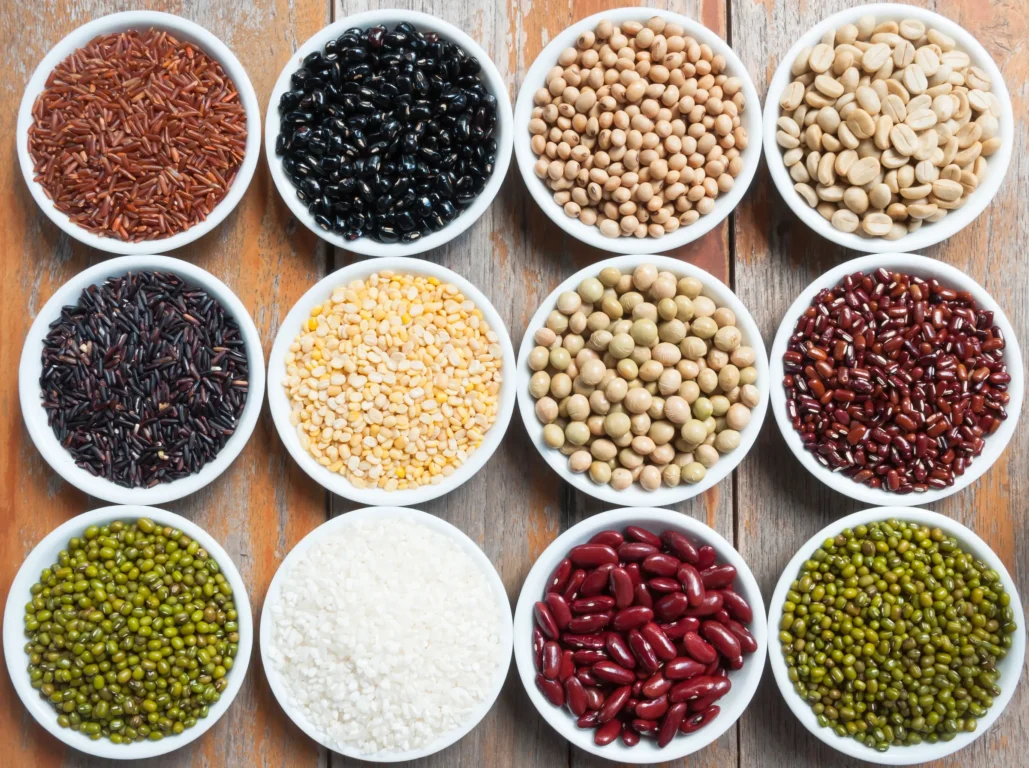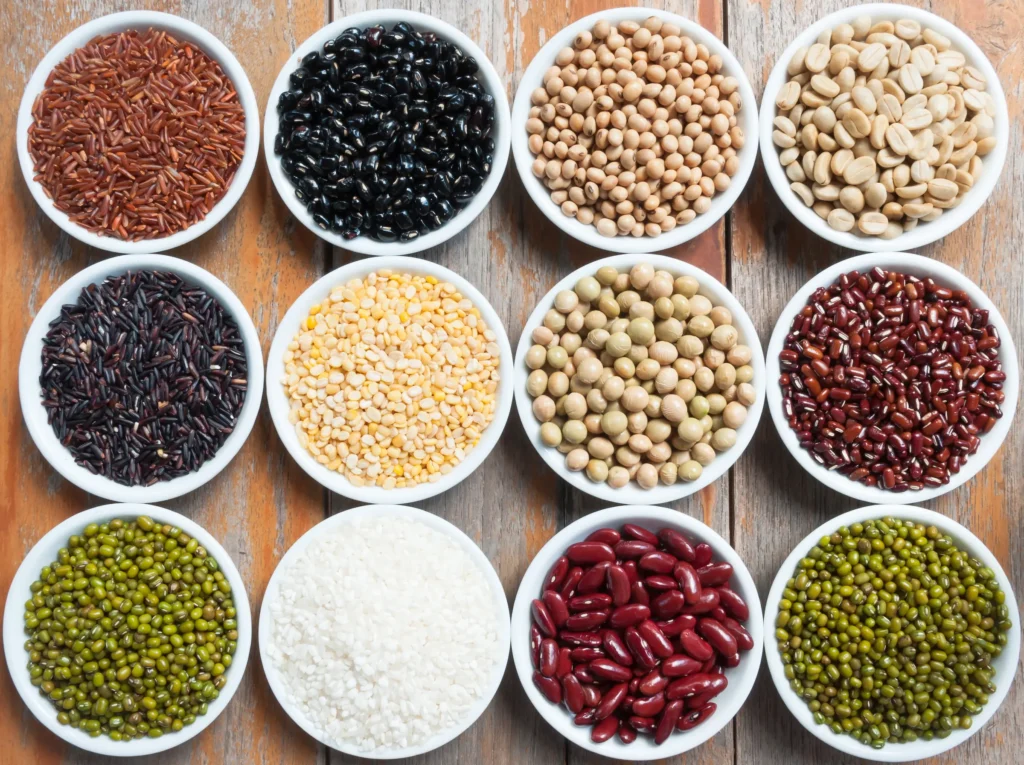You’re on a tight budget and need a cheap, convenient source of protein.
You want to meet your health goals, and you’re looking for healthy, tasty food that keeps you full for hours.
You’re a vegetarian trying to increase your intake of plant-based protein.
If you fit into these categories, you may not think beans are the answer; however, beans are one of the cheapest, most customizable, and healthiest proteins on the market. For thousands of years, they have been incorporated into dishes globally, and unlike many other plant-based products, dried beans are widely available all year.
Nutrition Benefits of Beans
Beyond protein, beans are a good source of fiber, with one cup containing approximately 15 grams. Fiber is a type of carbohydrate that can prevent constipation, decrease cholesterol, help control blood sugar, and lead to increased feelings of fullness after eating. Less than 10% of the US population meets the recommended daily fiber intake. Adding beans is an easy and convenient way to increase fiber intake.
Beans are packed with vitamins and minerals, including folate, iron, and antioxidants. Eating more beans can help reduce the risk of anemia, especially for those who follow a plant-based diet that is naturally lower in iron, as iron helps transport oxygen through the blood.
Are Canned Beans or Dried Beans Better?
When it comes to the benefits of beans, you may wonder whether canned or dried beans are better. Let’s find out.
Price
| Type | Average Cost Per Ounce |
| Dried beans, 20 lb (generic brand) | $0.05 |
| Canned beans, (generic brand) | $0.06 |
| Canned beans, name brand | $0.09 |
*Prices from Walmart.com, 3/21/2024
Sodium content
Canned beans usually contain more sodium than dried beans. However, it is becoming increasingly easier to find low-sodium or even no salt added versions of popular bean varieties such as black beans, chickpeas, and pinto. Additionally, they are often offered at the same price as regular. If you cannot find this option at your store, we recommend draining and rinsing your canned beans to reduce up to 30% of the sodium content.
On the other hand, dried beans are 100% free from added sodium and preservatives, making it easier for consumers to control their salt intake.
Flavor
Dried beans provide the freedom to experiment with new cooking methods and seasonings, as opposed to pre-cooked canned beans. Add seasonings or low-sodium broth as the beans cook to flavor the final dish.
In addition, dried beans are dehydrated shortly after harvesting, producing a fresher-tasting bean than canned varieties.
Texture
Dried beans often have a firmer texture than canned beans since they do not have to go under the heat treatment that canned beans do, which can contribute to a softer texture.
Buying in bulk
Dried beans have a longer shelf life than canned beans, making them perfect to buy in bulk for cheap and store for later use. Dried beans in bulk also produce less food waste since you can prepare the exact amount you need at a time.
Meanwhile, canned beans in larger cans are great to use for a larger family or if you plan to freeze your cooked meal for later use.
Overall, whether you buy your beans dried or canned, incorporating beans is an easy way to improve your diet.
How to Cook with Dried Beans
Dried beans cook faster and become more digestible when they are soaked overnight before cooking. After soaking and rinsing with cold water, the beans are ready to be cooked. It’s as simple as that!
A pot or a slow cooker is often the easiest cooking method. Just simmer the beans in water for 1-1.5 hours or until tender. Add seasonings such as onion, garlic, dried herbs, or spices to enhance the flavor.
Varieties of Beans
With over 100 types of dried beans available, you will find a type that suits your taste. This diversity may come as a surprise, considering that canned beans often stick with traditional varieties such as kidney beans, black beans, chickpeas, or pinto beans. In comparison, dried beans may include unique types such as fava beans or yellow eye beans.
Here is a breakdown of the most popular varieties:
Pinto Beans
Cooking time: 90 to 120 minutes
Who doesn’t love refried beans? Pinto beans are the base of this dish and many other common dishes, including ham and bean soup, charro beans, or as the main ingredient in bean burritos. They have a mild flavor and creamy texture, making them an easy addition to recipes, especially in Mexican cuisine.
Chickpeas
Cooking time: 30 to 120 minutes
Hummus, a creamy dip often used in Mediterranean-style dishes, is the most common use for chickpeas. These beans are round with a slightly nutty flavor, and in addition to hummus, they can create vegetarian burgers, pasta, curry, or be roasted to make a crunchy, on-the-go snack.
Black Beans
Cooking time: 60 to 90 minutes
These beans are versatile, and they are used in everything from tacos and dips to chili. They are unique from other beans in their appearance and flavor, and they are a go-to in Latin American and Caribbean cuisine.
Lentils
Cooking time: 15 to 20 minutes
Although lentils and beans both classify as legumes, lentils have a shorter cooking time compared to beans, making them a quick add-in for healthy dishes. Beans and lentils have similar health benefits; however, lentils contain slightly more protein and fiber, and almost double the amount of iron as beans. They are particularly beneficial for those who are anemic or for vegetarians who are seeking to increase their iron intake.
Lentils are classified as green, brown, red, or black lentils, among other varieties. Green lentils are the most common type, with green, brown, and black lentils being the most common additions to salads or soups. Red lentils are ideal for curry due to their creamy texture after cooking.
Applications
Are you unsure how to include dried beans in your diet without spending extra time preparing them? Let’s discuss how to make beans a staple in your meals.
Try sneaking beans into your diet by mixing them with any rice dish, pair them with breakfast dishes such as scrambled eggs or breakfast burritos (especially black beans), or into salads (lentils or roasted chickpeas work well). You can also puree and blend into dips, soups, or sauces. Blend white beans into creamy soups, black beans can create a tasty, healthy dip, and chickpeas are perfect for hummus, which is a delicious snack to pair with carrots or multigrain crackers. If you’re feeling creative, add black beans to baked goods such as brownies for a fiber-rich boost to a familiar favorite!
For easy, healthy recipes featuring dried beans, check out our recipes for Red Beans and Rice or Pork Green Chile Stew.
Storage & Shelf life
Store dried beans for 1-2 years or longer in a cool, dry place. While you should use canned beans within 3-5 days of opening, you can portion out the exact amount of dried beans to fit the recipe and return the remainder to storage, reducing food costs and waste through more flexible portion sizing. Dried beans are also not sensitive to changes in temperature or structural damage to the can.
Meal prep
Whether you pre-soak the beans, pre-cook the beans, or create a full recipe out of them, preparing meals in advance will save you time and help make the healthy choice easy. Dried beans are meal prep friendly: they can also be cooked and put in the freezer for up to six months. Our recommendation is to freeze them in resealable baggies into servings of 1.5 cups (which is the same amount as a can of beans) to make portioning easy. When you’re ready to use them, simply thaw them overnight. This way, you’ll have homemade, conveniently packaged portions of beans to throw into your favorite weeknight recipes!
What do I do with leftovers?
Eat the beans within 3-5 days after you cook them. If you don’t finish your food within this time, move the beans to the freezer where they will stay good for up to six months.
Summary
Dried beans are an easy, cheap, customizable, and widely available food that can take your nutrition game to the next level. Beans flavor everything from soups to baked goods, from Southeast Asia to Latin America, and will be the perfect budget-friendly addition to your pantry.
What’s your favorite way to use dried beans? Comment down below!


